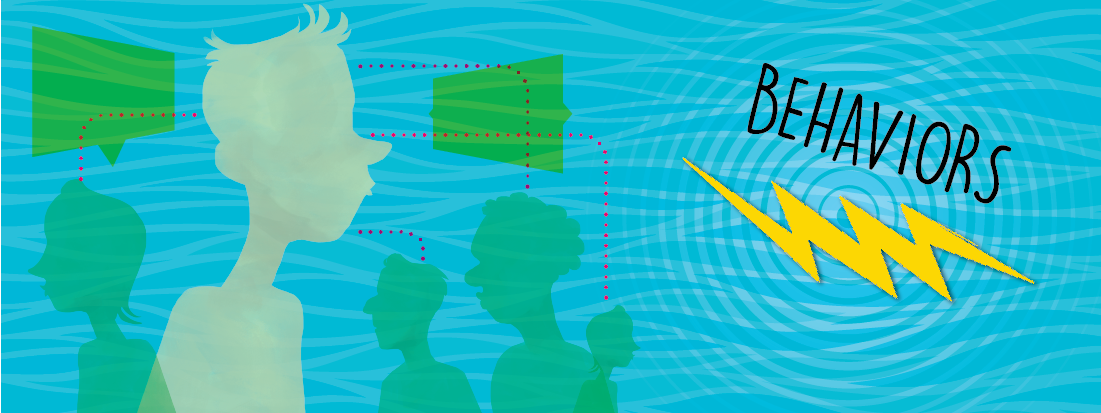Experiences → Attitudes → Behaviors: The Secret to Real Change
Strategies and plans are necessary, of course. But those alone will get you nowhere when it’s people you need to make real change. Three people factors can make or break your efforts when it comes to successfully creating change at work – their experiences, their attitudes, and their behaviors.
Experiences
What kinds of experiences do employees have at work? Employee experience most directly correlates to how managers treat employees, company culture, work environment, and the information they receive about performance, expectations, benefits, and corporate responsibility.

Let’s look at the impact of employee experiences on the customer. The customer experience you’re aiming to deliver can never exceed your people’s work experiences. Happy, empowered employees deliver the best customer experience, so ensuring they have positive experiences at work should be the cornerstone of any customer experience strategy. We’ve found that managers of high-performing teams achieve remarkable results because their employee experience is exceptional based on:
- Connecting with their employees in positive, empowering, and inspiring ways.
- Helping people understand the big picture of where the company is headed and how each person makes that happen.
- Encouraging smart risk taking and appreciating the lessons employees learn from making mistakes.
When your employees feel they’re part of a team; have a clear understanding of how they’re contributing to the organization’s strategy and results; and interact with their managers, leaders and colleagues in a positive way, their attitude shows it. Let’s explore how that works.

Attitudes
They say, ”Attitude is everything.” Some people wonder if attitude is a trait a person is born with or a function of their DNA. We’re not geneticists, so we’ll leave the DNA conversation to the scientists. But, since we study and consult on workplace and employee performance and have been helping organizations and the people who work in them thrive for decades, we know that employees form attitudes based on three things:
- Their experience: See above.
- Their emotions: It was an emotional decision. I made an emotional purchase. Our attitudes about work are heavily influenced by how we feel about it. Research shows that attitudes driven by emotions are the most difficult to change.1 When you’re trying to create organizational change, how your people feel about that change plays a critical role. Change can be uncomfortable and scary for employees. Acknowledging that fact is the best place to start. When you come from a place of empathy and let your people know that you’re open to hearing how they feel, you’re bound to see people having more positive attitudes and more easily achieving the desired outcomes.
- Their colleagues: When colleagues we respect share their opinions about work – whether they are right or wrong, positive or negative – we listen. Our coworkers influence our attitudes and drive our own decisions at work.2 Like consumers who ask for their friends’ recommendations on what to buy or where to eat, employees often seek information from colleagues informally in the break room, over lunch, or in a text. So, it’s not surprising that word of mouth around the office is much more influential on employee attitudes than anything you could put in print, PowerPoint, or an email. Once we accept that employees always have a powerful impact on each other’s perspectives, we can start to do a better job of bringing those influences out of the break room corner and into the light of our bigger organizational conversations.
Consider your attitude about work. How confident are you that it is helping to make you and your organization successful? What experiences have shaped your attitude? How does your attitude reflect in your behavior? Let’s take a closer look.
Behaviors
Behavior is the way in which we act or conduct ourselves, especially toward others. As we just learned, many things affect workplace attitudes and we must pay attention to them because ultimately, attitudes are what directly drive a person’s behavior on the job. Research shows attitudes that drive a person’s behavior meet three criteria:3
- The attitude is held with confidence – the person is certain of how they feel.
- The attitude is based on personal experience – the person knows from their own interactions why they feel the way they do.
- The attitude is based on easily remembered events – these direct experiences happen quite often to the person.

In short, when someone is confident in how they feel based on their own frequent experiences, it’s going to manifest itself in how they behave. Makes sense, right? Take a moment to think about how you behave at work. Do you act competently and professionally? Do you set an example for others to follow when they’re working in teams or across departments? Do you put forth all your effort or only some? Are you disciplined or lackadaisical? Without a doubt, no matter your answers, it’s your attitudes that brought you to where you are, and your experiences that shaped those attitudes. This is true at every level of the business – from the CEO to the front line.
 So, what do we do?
So, what do we do?
We absolutely MUST embrace this single truth: the experience our employees have shapes their attitudes, which drives their behaviors in the workplace. These behaviors impact the work they produce, the experience they deliver, and ultimately the entire organization’s success or demise.
- Take stock of your culture and work environment: Are there conditions or requirements that employees experience negatively? Does the organization promote a culture that’s conducive to shaping and maintaining the attitudes and behaviors you need to thrive?
- Be honest about the role of emotions at work: Being real and admitting that change is hard opens all new avenues of communication and trust with employees. Give them the permission and space to talk informally in small groups or “huddles” rather than pushing everything to happen at the corporate communications level or in a formal presentation.
- Train managers to elevate the employee experience: Offer learning modules, coaching, or workshops to give your managers what they need to treat their people with respect, even in conflict situations, and meaningfully engage them in work.
- Involve respected employees as change ambassadors: Use employee word-of-mouth power to benefit the change you seek. Convince them of your case for change, teach them the role of influencer, and hold them up as examples for other employees to emulate.
- Get people in it with their heads, hands, AND hearts: People need to see, touch, and feel it to believe it. Don’t only tell; you’ve got to show the why, how, and when of your change so everyone understands where they fit in the big picture. And then give them ways to recognize one another when they see success happening in the process.
- Have a plan to make it stick: Real change takes consistency and grit. Showing commitment to making and sustaining change will influence how your employees experience the idea of that change, and hence their attitudes and behaviors.
Remember, focusing on behavior alone – the last in the cascade of experiences -> attitudes -> behaviors – may yield some short-term results, but that’s it. Getting to the root cause of behavior at work is what positions us to create positive, lasting change. When the experiences are good, the attitudes are positive, and the behaviors follow suit!
1: Glasman, L. R., Albarracin, D. (2006). Forming attitudes that predict future behavior: A meta-analysis of the attitude-behavior relation. Psychological Bulletin, 132 (5), 778-822.
2: Clarkson, J. J., Tormala, Z. L., Rucker, D. D. (2008). A new look at the consequences of attitude certainty: The amplification hypothesis. Journal of Personality and Social Psychology, 95 (4), 810-825.
3: Rocklage, M. D., Fazio, R. H. (2015). On the dominance of attitude emotionality. Personality and Social Psychology Bulletin, 42 (2), 259-270.







